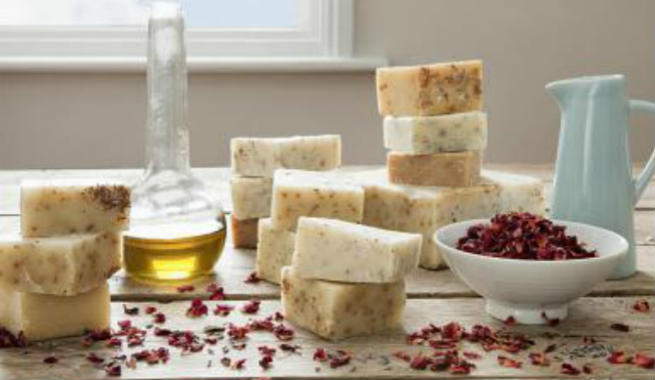Have you ever thought of trying a bar of shampoo to clean your beautiful locks? Sounds a bit awkward, right? But trust me, treating your hair with a homemade natural solid shampoo bar is far better than the chemical-filled liquid shampoos readily available. Here is a DIY recipe for you to try out: (1) (2)
DIY Homemade Shampoo Bar/Solid Shampoo Recipe
Ingredients Needed:
- Organic coconut oil – 10 oz. (up to 30%)
- Extra-virgin olive oil – 10 oz. (up to 50%)
- Organic castor oil – 6 oz. (up to 10%)
- Tallow or palm oil – 10 oz. (up to 50%)
- Lye (sodium hydroxide) – 5 oz.
- Distilled water -12 oz.
- Essential oils – 1.5 oz. (2 to 3 types as per your choice)
Supplies Required:
- A glass/plastic (must be of high-quality) mixing bowl (you cannot use this bowl for keeping foods anymore after making your solid shampoo as the recipe includes lye)
- A wooden spoon (keep it separate too)
- A crockpot (or any other kind of non-reactive pot)
- Two cooking thermometers (for the lye mixture and the oils)
- A silicone soap mold
- A digital scale (for precise measurement)
- An immersion blender
- A pair of rubber gloves
- A protective eyewear
- White Vinegar (optional – in case the lye mixture spills on your skin, it will be handy for neutralization)
- A medium-sized cardboard box
- A towel
- A large knife
How-To Guide:
- Before starting the procedure, ensure you are taking all sorts of precautions. Wear protective eyewear and put on a pair of rubber gloves.
- Now, find a well-ventilated place and start making your homemade shampoo bar. Take the glass or plastic mixing bowl and pour distilled water into it.
- Add lye or sodium hydroxide to water very slowly until all the lye is used up, and keep stirring the mixture with the wooden spoon. Be extremely careful during this step as the mixture of lye and water becomes very hot and can cause harm if it spills out. Stirring it continuously will allow the reaction to occur, and the concoction will cool down gradually. Use the cooking thermometer at this stage to keep track of the rising temperature and avoid danger. The ideal temperature should be anywhere between 100 degrees and 120 degrees.
- Measure organic coconut oil, extra virgin olive oil, organic castor oil, and tallow precisely with the help of the digital scale and pour them into the non-reactive pot or crockpot one by one.
- Put the pot over heat and start warming up the oil blend slowly. The objective is to bring the temperature of the oil blend and the water-lye mixture between 100 and 120 degrees. For convenience, make use of the other cooking thermometer at this stage.
- Slowly add the water-lye mixture once the oil blend reaches the right temperature. Use the immersion blender to combine both mixtures and create the trace. To find out whether you have reached trace, turn the blender off and pull it up to let some of the mix drizzle off. If it still has a consistency like fluid but does not fall back easily within a few seconds, you are done with your trace.
- Now, add all the essential oils of your choice to this trace one after another. Stir again to mix up everything. If you are not a vital oil person, follow this step.
- Your mixture for solid shampoo is now ready. Pour it carefully into the silicone soap mold.
- Keep the soap mold aside on a flat surface and cover it fully by placing the cardboard box over it in an upside-down position. Spread the towel over the cardboard box and wait for 24 hours. This will ensure that the saponification goes on in a warm environment.
- Utilize this waiting time by cleaning and washing all the supplies used. Always use hot, soapy water for this purpose. Add white vinegar to the water to neutralize and remove the lye.
- Once the saponification is complete after 24 hours, remove the solidified shampoo from the silicone soap mold and place it on a flat wooden surface.
- Slice the sizeable solid shampoo bar into smaller bars of around 1-inch thickness.
- Keep these shampoo bars separately in a well-ventilated area for 4 to 6 weeks.
- Voila! Your homemade shampoo bars are ready to use.
Method of Use/Application:
The usage of shampoo bars is more or less the same as any bar soap. Start with getting your hair completely wet. Rub it with the shampoo bar gently until a lather is formed. Massage your hair and scalp with both hands for a few minutes, then rinse well with plain water. You might need to wash your hair multiple times and follow it with a final acidic rinse.
Summary
Crafting your natural shampoo bar offers a chemical-free alternative to commercial liquid shampoos. This DIY recipe includes organic coconut oil, extra-virgin olive oil, organic castor oil, and tallow or palm oil blended with lye and essential oils. Safety precautions are crucial during the process. After mixing, the soap mold is covered for 24 hours to allow saponification. Once solidified, the shampoo bar is cut, cured for 4-6 weeks, and ready for use. The application involves wetting hair, lathering, massaging, and rinsing thoroughly.



